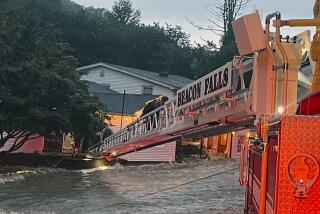Cold and another storm threaten Sandy’s homeless and powerless
- Share via
Since super storm Sandy ravaged neighborhoods and disrupted power along the Eastern Seaboard, tens of thousands of newly homeless Northeasterners and hundreds of thousands more without heat faced temperatures in the 30s this weekend. Residents scrambled to stay fed, warm and alive as a short-term crisis expands into what officials say will be long-term recovery.
“People are in homes that are uninhabitable,” New York Gov. Andrew M. Cuomo said in a Sunday morning news conference. “It’s going to be increasingly clear that they’re uninhabitable when the temperature drops and the heat doesn’t come on.”
As with many of the complications that have challenged officials’ recovery efforts thus far, it’s not just the cold that survivors have to worry about. “We’ve already had fatalities from those trying to heat with propane grill and whatnot,” said Edward P. Mangano, executive of New York’s Nassau County on Long Island, which reported 266,000 customers without power. The total in New York state was 730,000.
INTERACTIVE: Before and after Hurricane Sandy
New Jersey still had nearly a million customers without power, and residents faced fuel rationing implemented by Gov. Chris Christie.
Gas woes continued to immobilize many in the region. “My wife waited 2.5 hours for gas and called me every half-hour saying what am I doing about it?” New York U.S. Sen. Charles E. Schumer said.
Sandy left at least 110 dead across the Eastern Seaboard and brought a host of immediate obstacles to residents and officials who must also orchestrate a national election in two days and survive the threat of another nor’easter later in the week.
The new storm brewing off the coast of the Atlantic could hit Nov. 7 or 8, according to the National Weather Service. Forecasters predicted it could bring rain, snow, flooding and 55 mph winds to areas shattered by Sandy, leaving residents especially vulnerable.
The signs of recovery, however, were accumulating, as volunteers, supplies and relief money flooded into the region. After a long week of submerged subway tunnels and bumper-to-bumper traffic, the transit system began sputtering back to life. The 2, 3, 4 and 5 subways resumed routes beneath the East River and the D and J trains barreled over the Manhattan and Williamsburg bridges. The South Ferry station in Lower Manhattan, which Gov. Cuomo likened to “a large fish tank,” has been pumped dry.
Meanwhile, New York Mayor Michael R. Bloomberg promised that schools would reopen Monday even if kids had to be bused to different buildings than usual. “I’d rather go through the pain and the annoyance than miss another day of school,” he said Sunday morning. “Our kids have not had school for a week, and this is damaging them for the longer term.”
He swore, too, that he would ride the subway on Monday, determined to show that life would continue as normal. His attitude met resistance last week after he announced that Sunday’s New York City marathon would continue, forcing him to make an uncharacteristic retreat.
Not retreating from New York, however, were the runners themselves, hundreds of whom reportedly arrived at Central Park to run anyway and bring relief donations and supplies to storm survivors.
It was just one example of the many informal networks that have cropped up in New York to fill gaps where the government or Red Cross’ relief efforts fell short. Occupy activists, working under the title Occupy Sandy, turned their improvisational organizing skills toward relief work in Queens, whose Rockaway peninsula has been shredded by storm waters and scarred by fire.
On Sunday, the Federal Emergency Management Agency reported receiving 122,000 claims for disaster assistance from New York, New Jersey and Connecticut, with $107 million in relief funds approved for disbursement.
“We don’t leave until everything’s done,” FEMA Administrator Craig Fugate said at a Sunday morning news conference, cautioning that the recovery “will not be done in a year.”
Connecticut Gov. Dan Malloy said Saturday that once that state’s residents had power back, “we will be good neighbors” and send help to New York and New Jersey.
With New York City unlikely to face the kind of exodus that hit New Orleans after Hurricane Katrina, local officials faced pressure to find housing for 30,000 to 40,000 residents in a city with occasionally brutal winters where a decent apartment can be hard to find.
“If there is a silver lining in this truly tragic storm, it is to see New Yorkers come out and come together, it’s to see the spirit of community and the spirit of neighborliness,” Cuomo said. “The nation knows New Yorkers as tough, that we’re tough. We’re tough! But we’re also sweet and we’re kind and we’re generous, and we’re giving, and you can see that all over the state today.”
ALSO:
Hurricane Sandy death toll climbs above 110
Uneasy quiet: Sandy brought New York an eerie silence
N.J. begins gas rationing as region rebounds in Sandy’s wake
More to Read
Sign up for Essential California
The most important California stories and recommendations in your inbox every morning.
You may occasionally receive promotional content from the Los Angeles Times.











